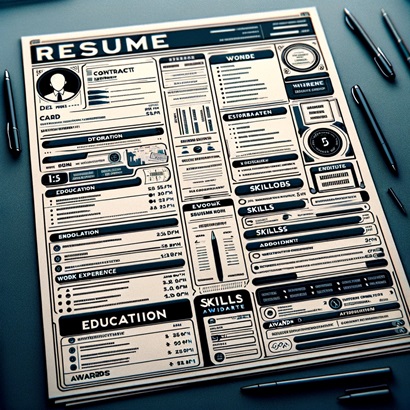Resume Sections: What to Include and Exclude
Resume Optimizer Pro Editorial Team
Updated May 22, 2025

Crafting a resume that stands out involves not only highlighting your best achievements but also knowing what to include and what to leave out. This guide will navigate you through the essential sections that should be part of any resume, as well as those that are better left off. Understanding what to include and exclude can significantly impact how your resume is perceived by potential employers.
Contact Information
The contact information section is crucial as it provides employers with the means to reach you. This should be the first section on your resume, positioned at the top for easy visibility.
Essential Details
Include your full name, phone number, professional email address, and your location (city and state). Ensure that the email address sounds professional, using your name without any frivolous numbers or characters.
What to Exclude
Avoid including personal details that are not relevant to your job application, such as your date of birth, marital status, or social security number. These details do not pertain to your professional qualifications and should not be included in your resume.
Professional Summary
A well-crafted professional summary can capture the attention of hiring managers by succinctly stating who you are, what you can offer, and what your professional goals are.
Tailoring Your Summary
This section should be a brief 3-4 sentence summary that reflects your professional persona and highlights your most significant achievements. Tailor this section to align with the job for which you are applying by mirroring the language and requirements stated in the job description.
Common Mistakes
Avoid generic and vague statements that could apply to anybody. Instead, focus on unique qualifications and specific accomplishments that set you apart from other candidates.
Work Experience
This is arguably the most important section of your resume. It provides a detailed look at your professional history and what you’ve accomplished in your career thus far.
Structure and Content
List your work experience in reverse chronological order, starting with your most recent job. For each position, include your job title, the name and location of the company, and the dates of your employment. Under each job, provide a bullet list of your responsibilities and achievements, focusing on those that are relevant to the job you are applying for.
What to Leave Out
Do not include every single job you’ve ever had. Focus on the positions that are relevant to the job at hand. Jobs that do not relate to the position or are outdated can generally be omitted unless they fill a gap in your employment history.
Education
Your educational background is also vital, especially if it is a requirement for the job or relevant to the position you are applying for.
Details to Include
List your most recent educational experiences first, including the name of the institution, the degree obtained, and your graduation date. If you have graduated recently, you can also include honors or your GPA, especially if they are impressive.
Irrelevant Information
If you have been in the professional world for some time, you can leave out your high school education or details about coursework that is not relevant to the job. Focus on higher education and any other professional training that is pertinent to the job.
Skills
The skills section of your resume allows you to directly list the abilities that qualify you for the job. This can range from technical skills to soft skills that are applicable to the position.
Highlighting Relevant Skills
Be sure to list skills that are directly related to the job. This could include software proficiency, languages, and interpersonal skills. Make sure these are tailored to meet the requirements listed in the job posting.
Common Errors
Avoid listing skills that are unrelated or assumed basic at the professional level, like 'email'. Such entries can take up valuable space that could be used for more compelling content.
Optional Sections
Depending on your industry, there might be additional sections that are worth including, such as publications, certifications, or professional affiliations.
When to Include
These sections should only be added if they provide value to your resume and are relevant to the job you are seeking. For instance, certifications in project management are a plus for a project manager role.
What to Exclude
Generally, you should omit sections like hobbies, references, and overly personal information, as they do not enhance your professional profile. If employers are interested in references, they will ask for them later in the application process.
Conclusion
Crafting a well-organized and impactful resume involves more than just listing your experiences and skills; it requires strategic thinking about what information will best showcase your qualifications and meet the employer's needs. At Resume Optimizer Pro, we specialize in optimizing each resume section according to best practices for resume writing. Our expertise ensures that every part of your resume is crafted to enhance your chances of landing your ideal job. Let us help you refine your resume to make the strongest possible impression on potential employers.